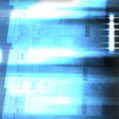 Fight.Boredom recently sat down with local print guru Jeff Herndon, president and founder of the print brokerage firm Aurora Print Services. Jeff has over 20 years experience in the print industry and often works Cloudjammer on print projects.Fight.Boredom:
Fight.Boredom recently sat down with local print guru Jeff Herndon, president and founder of the print brokerage firm Aurora Print Services. Jeff has over 20 years experience in the print industry and often works Cloudjammer on print projects.Fight.Boredom: So let's get started with the big one...what is the big difference between an offset printer and your local copy shop?
Jeff Herndon: Digital printing is the difference. Copy shops, like Kinkos, use laser printers, large format inkjets, and color copiers (some of them high end, like the Docutext or the Indigo) and print straight from the computer. The print quality is good, but not great, and they are very limited on the selection of papers and weights. They're great for short run prints, but high-volume jobs are very expensive.
Offset printing is a whole other animal – and has come a long way in the last several years. Most offset printers now use direct to plate technology, instead of making and burning negative film and then processing the plate. The printing process uses a separate impression cylinder for each plate, or color, where the digital printers only use one. The quality so much surpasses digital printing I can’t imagine why anyone running a sufficient quantity uses anything else.
FB: The difference is really quite huge, then?
JH: It's like the difference between regular TV and HDTV – If you look at offset and digital prints separately the untrained eye probably won't see much of a difference, but if you look at them right next to each other than the difference is obvious. People don’t know and don’t see it until it's pointed out to them. They need to see it side by side…the difference is subtle, but enormous in quality. Digital can't touch that.
FB: I like where this is going. Down with Kinkos! Are there any other big differences between most offset and digital printers?
JH: The people running the equipment. Anyone can run a Xerox machine. The people who work in offset printing, though, apprentice for 3-4 years before they can become journeymen. There are special printing colleges and paper science schools, like the one at Georgia Tech. They learn how paper and printing works together and can tell you what problems will likely arise before you even get on press. Kinkos can't give you that. Their people are just trained to know a little bit about everything ...quality and fulfillment are not a big deal at most copy shops.
FB: So why would anyone take their project to a copy shop?
JH: Cost, for one. Consider what goes into a 4-color brochure – full color. On a digital press, the first sheet through the press is just as good as the last sheet. And the color isn't terrible.
On an offset press, however, it's not as simple. Files need to be positioned on plates to print in a larger press format. it can take you up to an hour to pull good proofs for 4-color matching. Then you have to burn four separate color plates through the imagesetter and get them on press. You then use 14-15 feet of paper to make ready on press and another 300 sheets to set register, one color at a time. Colors have to be adjusted. You'll use a minimum of 500-600 sheets of paper to get a 100 copies of your brochure. The technology has come a long way, but you still need to have realistic expectations.
FB: Oh. I guess I have to take back my "Down with Kinkos." Is there anything a digital printer can't do that an offset printer can?
JH: They can't match PMS colors, for one, and they can't print metallic inks. No aqueous or varnish coatings to protect your paper. They normally can't print on coated sheets, either. And don't go to them for pocket folders. They'll tell you they can do them. Instead of die-cutting and folding a single sheet to create the pocket folder, though, they just tape prefab pockets to the inside of a 9" by 12" color copy. The biggest laser printers they have are just too small to run pocket folders as they should be done.
Offset printers can do all of these things. Foil-stamping, engraving, embossing, thermography. They can use aqueous to speed up the offset process by removing the drying time between runs. You can run varnishes as spot colors.
FB: Can the digital presses do anything an offset can't?
JH: Copy shops have their unique benefits, sure. They can run individual pieces, like a mailing, through an indigo or docutext with a database supplying unique information to each print. You can change your piece with each impress, with no additional setup. They can also run large format banners and electrostatic prints that can be ironed on or laminated for outdoor use.
FB: But you did say that digital printers were limited by their paper choices, right?
JH: They don't have nearly the variety to choose from that an offset printer has. Most digital printers can't run anything heavier than 65 pound stock – a very moderate card weight. Offset can run much heavier stuff. Your business cards, for instance, are 135 pound double ply. Some paper mills are now supplying 180 pound stock! And digital presses are limited in their bindery techniques on these papers, too – usually just saddle-stitch and tape binds in a lightly equipped finishing department. Offset jobs and conventional binderies can do a wide variety of binds. You can even make elaborate pieces that use many kinds of binding.
FB: Wow. That's a lot to digest. Any closing thoughts, Jeff?
JH: Digital and offset – they each have their advantages and disadvantages. For small run projects, digital can do great work, but if you're going to run anything over 100-200 copies, you probably need to go offset. And don't take pocket folders or presentation brochures to Kinkos. The quality just isn't there. It's the difference between going to Quik Trip and the grocery store. You have to weigh speed against quality and selection.
FB: Like those analogies, don't ya?
JH: Sorry about that….one of those things I inherited.
fb
 To some, the Internet is known as a great gathering of information for everyone to use and share. Of course, the rest of the world knows it's a way to kill an otherwise boring day. Well, I have found a new website to help us carry the fight: Homestarrunner.com is the newest weapon in the battle to stave off boredom.
To some, the Internet is known as a great gathering of information for everyone to use and share. Of course, the rest of the world knows it's a way to kill an otherwise boring day. Well, I have found a new website to help us carry the fight: Homestarrunner.com is the newest weapon in the battle to stave off boredom.

